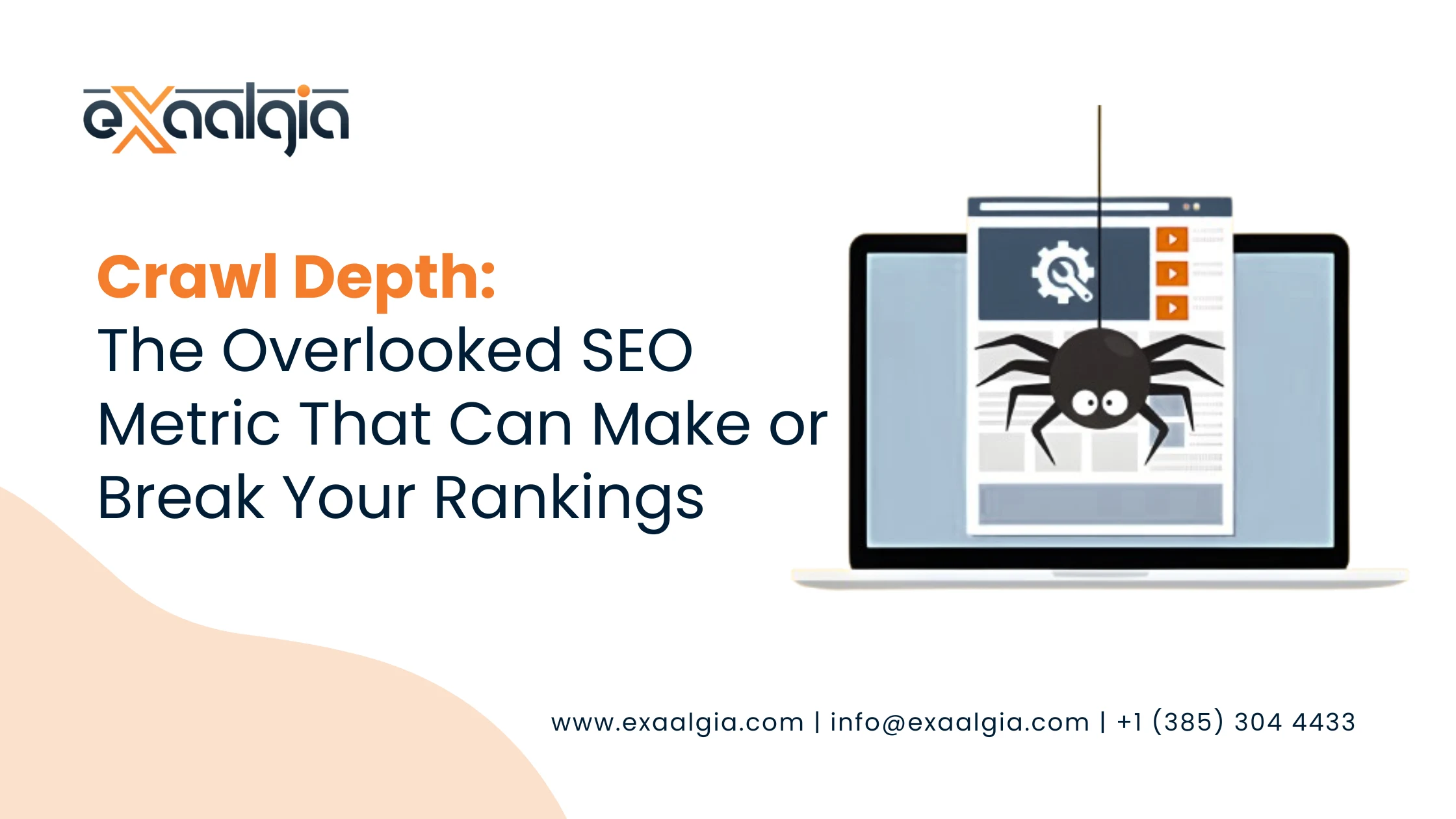Why You Need to Care About Crawl Depth
If you consider SEO, keywords, backlinks, or page speed likely come to mind. But crawl depth is a factor that’s influencing how well your site ranks, quietly shaping the way it performs.
Crawl depth is merely the amount of clicks it takes for a person, or a crawler from a search engine, to navigate from your home page to a particular page. Level zero is the homepage, level one is a page that is directly linked from the homepage, and so forth.
This may seem like a trivial detail at first blush. But search engines have a limited “crawl budget” assigned to each site, so they will only crawl a limited number of pages per visit. If your most critical content is five or six clicks deep, there’s actually a good chance it won’t get indexed in a timely manner, or at all.
This affects everything from opportunity rankings to user experience. Guests don’t enjoy burrowing through infinite menus to discover what they’re looking for. And if spiders can’t access a page readily, you can’t count on it doing well on Google.
That’s why crawl depth optimization needs to be part of any serious SEO plan. Here are ten advanced, battle-tested tactics you can apply to keep your content available, your crawl budget in good shape, and your rankings intact.
Why Crawl Depth is Important for Search Engine Optimization
1. Crawl Budget Optimization
Search engines allocate a certain crawl budget to every site, specifying how many pages they will crawl in a session. If most of those pages are deep down, bots won’t get to them all. A shallow crawl depth optimizes the limited budget so that key pages get crawled more often.
2. Faster Content Indexing
Closer pages to the homepage are crawled more frequently. New updates, product releases, or blog posts thus show up in the search results sooner when their crawl depth is less.
3. Enhanced Link Equity Distribution
Link equity, also known as “link juice”, travels more effectively through a flat structure. When there are fewer layers from the homepage to the key pages, internal links transfer more authority, improving the likelihood of ranking higher.
4. Better User Experience
Crawl depth does not only concern search engines. A shallow structure enables users to discover content quicker, lower bounce rates, and enhance engagement metrics.
10 Expert Techniques to Optimize Crawl Depth
1. Build a Clean, Hierarchical Site Structure
The best websites are organized like a well planned library. The homepage acts as the front desk, guiding users to categories, which then lead to individual pages.
A good rule of thumb, keep your key pages no more than three or four clicks away from the homepage. For an eCommerce site, that is to say that no product page should be nested several layers below in categories and filters. For a blog, your cornerstone posts must never be nested several clicks deep in old archives.
The payoff? Users are easier to navigate, and search engines invest crawl budget in the pages that are truly important.
2. Create Sitemaps That Work for Bots and Humans
Search engines adore clarity. An XML sitemap is a clear-cut line to crawlers, instructing them what pages there are, how often they are updated, and which ones are most important.
But don’t leave it there, make an HTML sitemap too. It is a plain, user visible page that outlines broad sections and links. Not only does this assist users in finding pages they may have overlooked, but it also provides additional crawl paths for spiders, reinforcing your site’s hierarchy.
3. Reinforce Internal Linking Throughout Your Pages
Internal linking functions as shortcuts that collapse crawl depth and link to pertinent content. Each link you include is an invitation for crawlers to crawl and reveal deeper pages.
As a copywriter, I suggest that you insert natural internal links into your content. If you write “SEO Services USA” in an article, link it to your specific SEO services page. If you are writing about “Shopify SEO“, link to a relevant case study or resource page.
Use descriptive anchor text, rather than “read more,” write “learn about our Shopify SEO strategies“. This adds context, enhances user experience, and enhances your SEO signals simultaneously.
4. Use Relevant, Descriptive Navigation Text
Search engines use link text (referred to as “anchor text”) to determine the content of a page. By using generic terms such as “click here” or “learn more,” you’re not giving crawlers, and users, a chance to know what they’re in for.
Be more descriptive in your navigation and link text and reflect the intent of the page. For instance:
“See our Web Design Portfolio” rather than “View More”
“Explore Our SEO Checklist” rather than “Learn More”
It makes navigation more natural and sends powerful cues to search engines regarding page relevance.
5. Optimize Depth for Very Large, Very Complex Sites
On sites with hundreds or thousands of pages, such as eCommerce sites or news sites, flattening it all out can cause navigation to feel overwhelming.
The intelligent way is to promote your best content. Bring higher-converting product categories, top sellers, or evergreen blog posts nearer to the homepage. Supporting or low-traffic pages may remain further in without negatively affecting SEO.
It makes user journeys simple, saves crawl budget wisely, and keeps usability and SEO in good balance.
6. Prominently Indicate New and Updated Pages on the Homepage
When you release new blogs, introduce new case studies, or release new collections, highlight them on the homepage for some time.
This reduces their crawl depth temporarily and informs search engines that such pages are fresh and valuable. Hence, they are indexed more quickly, which is essential for time sensitive content such as seasonal deals or news.
7. Optimize Pagination for Easy Crawling
Pagination is prevalent in forums, eCommerce product grids, and blogs, but it can also drive critical content too far out.
Adhere to best practices using:
- Clean, linear URL formats (such as /page/2/)
- “Next” and “Previous” navigation buttons
- Canonical tags if necessary to prevent duplicate content problems
This provides a seamless crawl path, guaranteeing all your content is discovered without wasting crawl budget.
8. Regularly Audit Your URL Inventory
Websites accumulate “clutter” over time, duplicate tags, stale campaign URLs, thin pages, and parameter based URLs that are not valuable.
Regular content and technical audits to:
- Consolidate or divert duplicate content
- Delete pages that have no use
- Use noindex on low-value or duplicate pages
Simpler website structure makes crawling quicker, enhances site speed, and maintains your crawl budget on your top performing pages.
9. Fix Broken Links and Remove Redirect Chains
Dead links present dead ends for crawlers and users alike. Redirect chains (one page leads to another, then another, etc.) consume time and crawl budget.
Identify broken links and chains using tools such as Screaming Frog, Ahrefs, or SEMrush. Repair them by changing the link to the last destination or eliminating old references completely.
This maintains your link equity and smooth navigation, which search engines prefer.
10. Crawl and Index Reports Check Periodically
Don’t just set it and forget it. Make use of Google Search Console to keep an eye on index coverage reports regularly.
This will indicate which pages are included, excluded, and if crawl problems are keeping some pages out of search results. Use this in combination with log file monitoring to see where crawlers spend their time, and do something about it if you spot important pages being ignored.
Why Crawl Depth Matters for SEO
Crawl depth optimization may sound technical, but it has a direct influence on business results. Improved crawlability equals faster indexing, which equals faster ranking gain. It also equals your users getting what they came for without hassle, leading to improved time on site and conversion.
In short, proper crawl depth management results in a site that’s easy to crawl, easy to index, and easy to rank.
Turn Crawl Depth Into Your SEO Advantage
Crawl depth is one of those under the radar SEO levers that differentiate well optimized websites from those that are fighting to rank. By streamlining your site structure, reinforcing internal linking, tracking index coverage, and keeping URLs concise, you make sure both users and search engines can easily access what matters, quickly.
The outcome is a healthier, more discoverable website that generates steady traffic and ranks better in search results in the long run.
Frequently Asked Questions
1. How deep are my pages best to achieve optimum SEO?
Ideally, retain your top pages no more than three to four clicks away from the homepage. Anything deeper than five clicks is deemed too deep and can damage indexing.
2. How do I determine my website’s crawl depth?
Utilize crawling tools such as Screaming Frog, Sitebulb, or DeepCrawl. These will indicate how many clicks it is to access each page from the homepage.
3. Does an XML sitemap fix crawl depth problems?
No, sitemaps assist with discovery but will not take the place of internal links. A page must still be properly linked to transfer authority and rank well.
4. How frequently should I optimize crawl depth?
For small sites, quarterly review is likely sufficient. Larger, high-traffic, and high-updating sites might appreciate an audit once a month to maintain crawl depth under management.
5. Can enhancing crawl depth enhance my rankings?
Indirectly, yes. By enhancing crawlability, you enhance the likelihood of content getting crawled fast and gaining link equity, which helps with better rankings.







